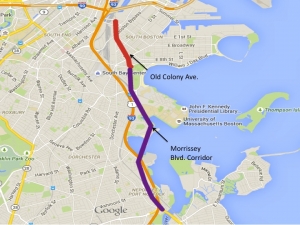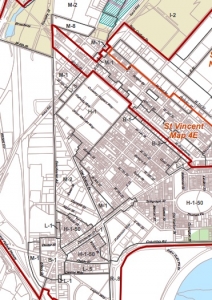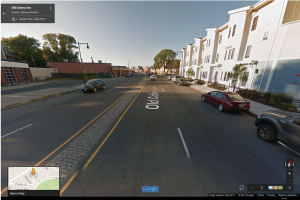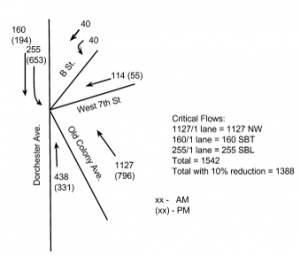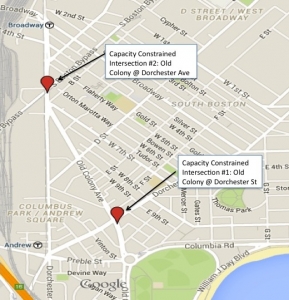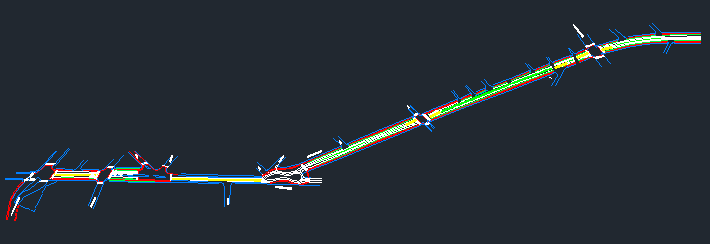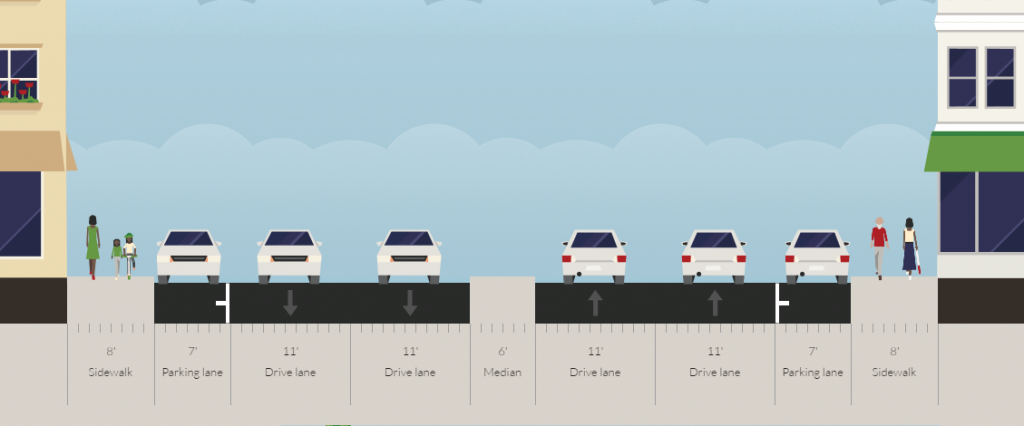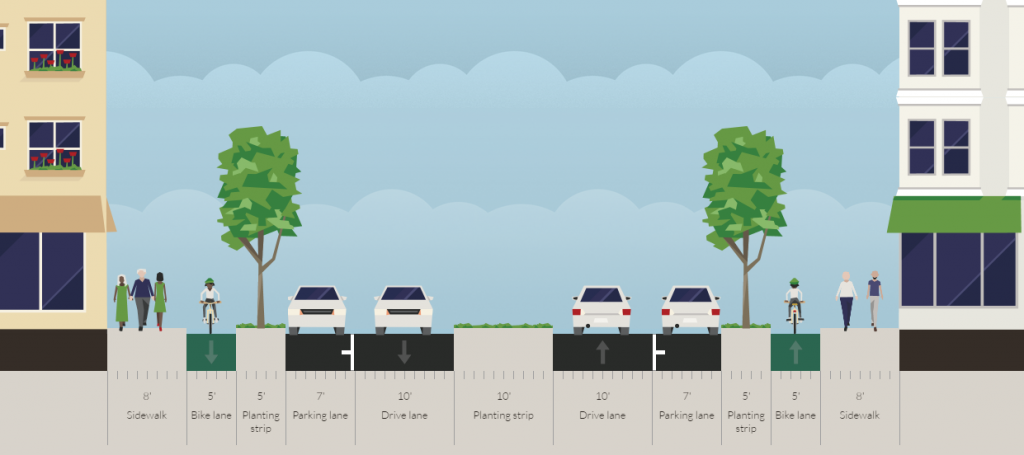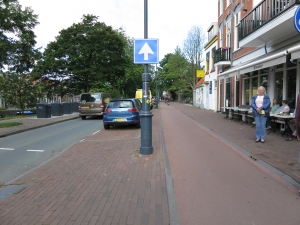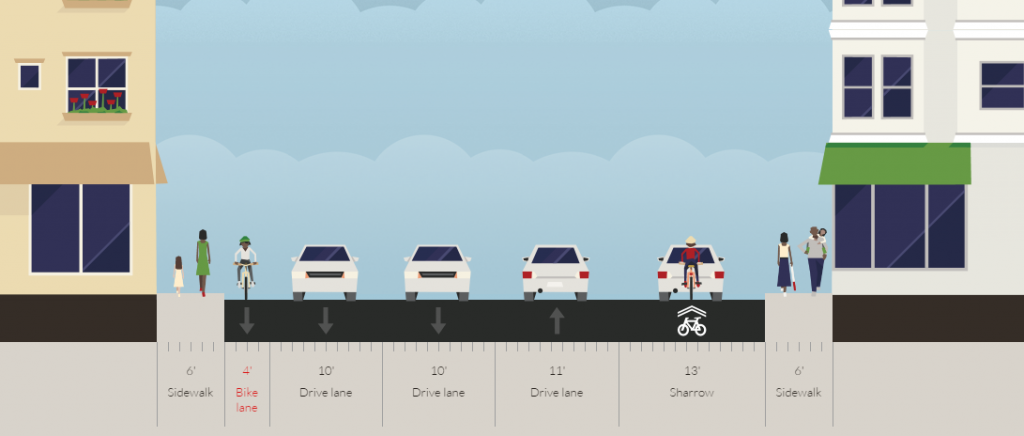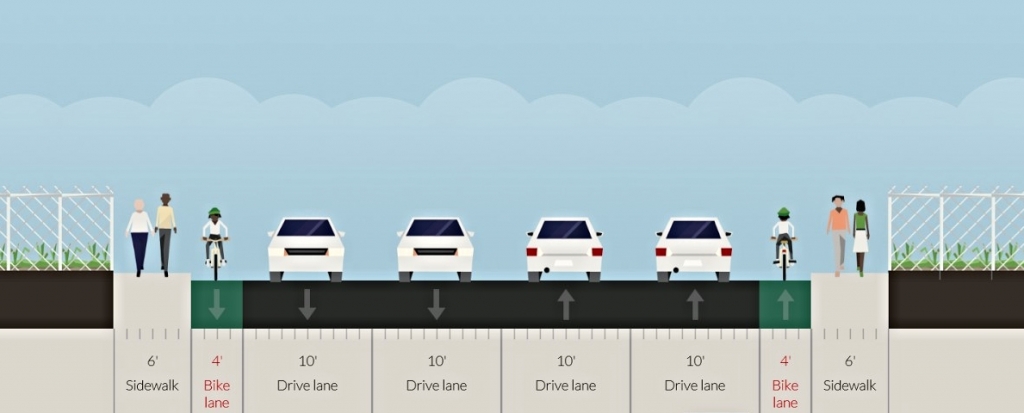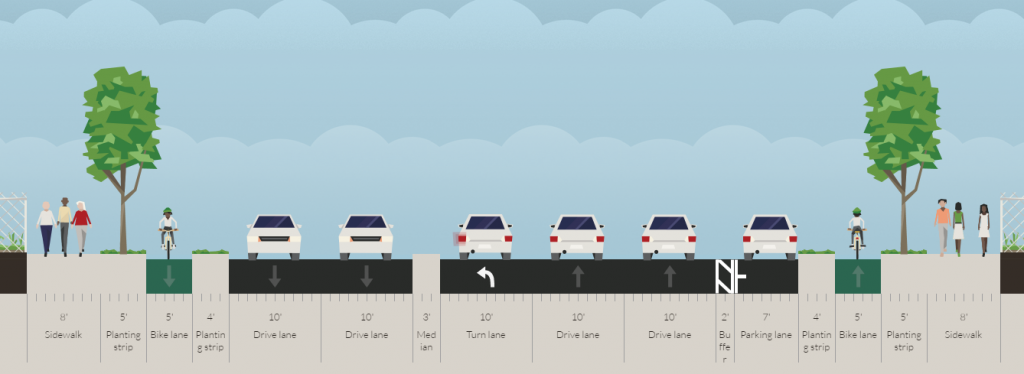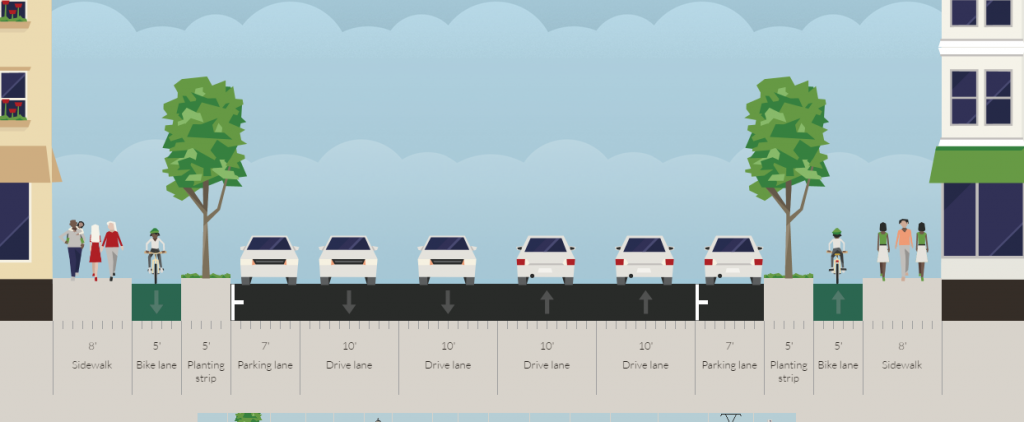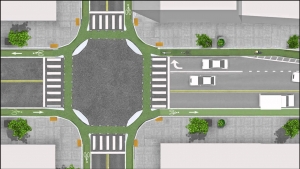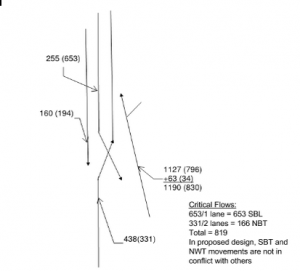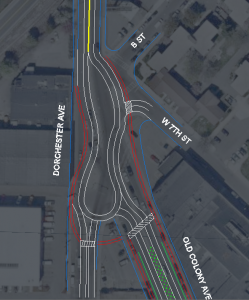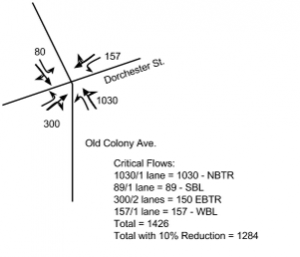Team: Christine Lai, Peter Calves, Chase McLaughlin, Kim Perrone
Existing Conditions
Old Colony Avenue is a major distributor road in South Boston. It used to be a major highway connecting to Morrissey Boulevard, but has since become more local. The one-mile stretch carries moderate amounts of traffic during rush hour, mostly being commuters exiting the Southeast Expressway.
It is also an integral piece to the bike network; it has the potential to connect the paths in Moakley Park and the Harborway paths to the south with the bike lanes on A street and the proposed Broadway paths to the north, after merging with Dorchester Avenue.
The area around Old Colony is mostly residential, with some more industrial buildings, local businesses, and a few office buildings. Most of the side streets are used by the local residents, while the other major businesses are located along Old Colony.
Currently, Old Colony Ave. has two travel lanes in each direction, a median, parking on both sides and no bicycle facilities. Old Colony Ave. then merges into Dorchester Ave. which is also a 2+2 road of varying width. There are sharrows allowing bikes to share the road with cars and for very brief sections there are bike lanes. These bike lanes are broken and scattered, with no connection to Old Colony Ave.
Design Objectives
- Create safe, comfortable bicycle routes up Old Colony Avenue
- Connect cycling routes to designed bike paths that other projects are planning from the Harborwalk at Joe Moakely Park in the south to the South Bay Harbor Trail at the Broadway T Station
- Slow traffic and reduce volume on Old Colony Avenue
Key Points
- Changing travel lanes on Old Colony Ave from 2+2 lanes (2 per direction) to 1+1 lanes as part of overall strategy to demote the Morrissey Boulevard corridor for local traffic
- Planning to utilize traffic diversions on Morrissey Blvd to highway from other projects to reduce volume on Old Colony by 10%
- Add cycle tracks with protected intersections by Dutch design on Old Colony and continuing on upper Dorchester Ave, with a shared-use path when necessary, to optimize safety and comfort
- Replacing Dorchester Ave intersection with roundabout to increase throughput while providing priority for cycle crossings
Capacity Analysis
Using turning movement counts provided, we could determine the volume and capacity of the intersections at Dorchester St and Dorchester Ave. The benchmark we were given for capacity was 1400 vehicles through the intersection during peak analysis periods.
The intersection at Dorchester St and Old Colony was slightly above the capacity threshold. As part of an overall plan to demote Morrissey Boulevard corridor, several changes would be made to the traffic capacity on this corridor. We believe an efficient way to mitigate the overburdened capacity would be by preventing 93 traffic from using the corridor as a cut-through. This should reduce traffic on Old Colony by the desired 10% for our project.
Due to the number of lanes at Dorchester Ave, that intersection was below the capacity threshold in the existing condition. However, when we brought Old Colony down to 1+1 lanes rather than 2+2, the intersection was over capacity with the existing signalized intersection. In order to resolve this situation, we will count on volume reductions due to the above proposed network mitigation, as well as the capacity improvements given by the proposed roundabout design at the Dorchester Ave intersection to relieve the overburden.
The below arrow diagram describes the major movements in the intersection where Old Colony Ave merges with Dorchester Ave, along with the intersections of B St and West 7th St with Dorchester Ave. This capacity in this case is determined by the critical movements, the highest volumes of movements that would conflict with one another. In the present condition the intersection is within capacity, but that will change in our proposed condition, with the lane realignment on Old Colony.
Proposed Design
Old Colony Avenue
Old Colony Ave is currently a 2+2 distributor road along residential roads with local businesses on the main drag. It has large sidewalks and a median that we preserve in our new design.
Our new design includes demoting the road to a 1+1 travel lanes. In the new space we will be putting in 5-foot wide one-way cycle tracks, buffered by 5 feet of grass with trees, and 7-feet parking lanes on the other side of that. We will keep the 8-feet sidewalks as well. In the travel lanes, they will come down to 10 feet with a 10-feet median that will turn into a left-turn lane at major intersections. Cycle track lanes and the buffer will stay the same through the intersections, but tree linings will end to provide better visibility.
Existing Old Colony Avenue
Upper Dorchester Avenue
At the northern end of Old Colony Ave, it meets Dorchester Ave to make a new upper Dorchester Ave section. This 2+2 section has a varying cross-section with changing widths, causing the bike lanes to be broken up, turned in sharrows, or just go missing completely from the road.
Our new design varies as the width of the road changes. On the narrowest section, a 10′ wide shared path will be implemented on either side. The cyclists will ride up onto the sidewalk, with signage warning pedestrians and cyclists that they are sharing this path. This section of road is a bridge so there are no businesses and therefore few reasons for pedestrians to be walking here. With little conflict between bicycles and pedestrians, we believe this option will still be the safest and least stressful for the cyclists along this route. A bike lane was out of the question, so this was the most desirable design. This is shown in the first proposed cross-section, between Dorchester Ave and A Street.
At the wider sections, between A Street and West 4th, the cycle track continues. We’ve also taken advantage of the space by restoring the trees and allow cyclists a buffer between them and the parked cars along the travel lanes. Unfortunately we do lose some of this space after the intersection, but enough is retained to keep a cycle track and even parking spaces for the offices along the road.
Existing Sections of Upper Dorchester
(between Dorchester Ave and A Street)
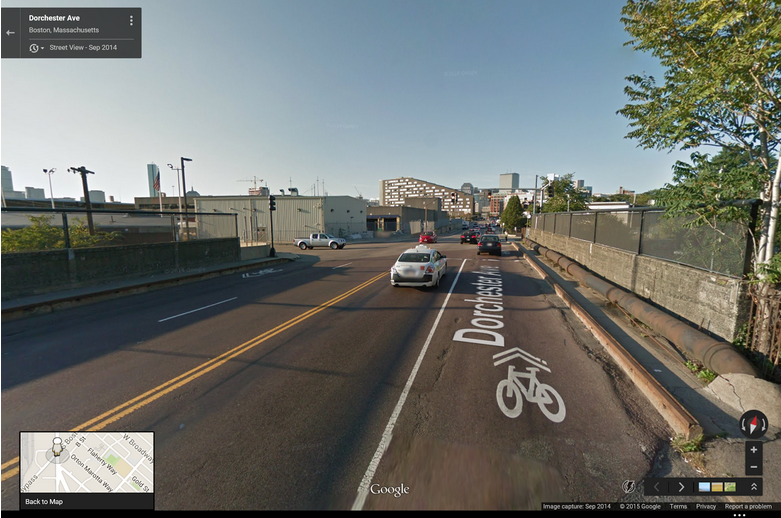
(between A Street and West 4th)
(between West 4th and Broadway)
Existing Upper Dorchester Ave Cross-Sections
(between Old Colony and A-Street)
(between A-Street and West 4th Street)
(between West 4th Street and West Broadway) 
Proposed Upper Dorchester Ave Cross-Sections
(between Old Colony and A Street)
(between A Street and West 4th)
(between West 4th and West Broadway)
Intersections
The intersections we redesigned are Dorchester Street, D Street, Dorchester Ave, A Street, West 4th Street, and West Broadway. These are all major crossings where cyclists and pedestrians cross more than 2 lanes of traffic.
To ensure a safe and low-stress route for a cyclist’s entire ride, we are also implementing Dutch-inspired protected intersections at every major crossing. These will be at Dorchester Street, D Street, A Street, West 4th Street, and West Broadway. Dorchester Avenue will have a roundabout, shown below. The protected intersections are designed with a small median is in the corner between the turning cars and cyclists. This forces the cars to slow down for a sharper turn, and pushes the cyclists out to the right to give the drivers a better view of the incoming cyclists to avoid right-hook collisions.
Semi-Roundabout at Dorchester Ave and Old Colony Ave
At the intersection between Old Colony Ave and Dorchester Avenue we took inspiration from a Dutch turbo roundabout. The roundabout will allow us to remove the traffic signal and increase capacity while keeping to our one lane design on Old Colony Ave. This Semi roundabout lets cars come with minimal conflicts through the intersection without stopping, however the curves in the road slow down vehicle traffic. Bikes and pedestrians benefit from this layout by both the reduction of delay and the reduced interaction with cars as more space is provided between the forms of transportation and the number of conflict area in reduced.
All entries to the roundabout will be perpendicular on the approach, forcing cars to slow down to make a sharp turn. (This may not be accurately depicted in the CAD drawing but the geometry can be easily fixed). There is curvature throughout the travel lanes. Pedestrian and bicycle crossings will be safe due to crossing tables, splitter islands, and the previously mentioned reduced speed of cars. It is important that crossings are unsignalized to preserve the good traffic flow provided by the roundabout.
Capacity was determined by the critical movements, the highest volumes of movements that would conflict with each other. For the proposed semiroundabout intersection, making the Southbound thru and Northwest bound thru movements non-critical by removing them from conflicts with the other directions greatly expanded the capacity of the intersection
Semi- Roundabout Traffic Capacity
Dutch Oval Roundabout Inspiration
Capacity after Redesign
How capacity will still work:
The arrow diagram shows the major movements through the Dorchester Street intersection. What creates the most constraint on capacity in our proposed condition is the changing of the lane configuration on Old Colony Ave. Capacity was determined by the critical movements, the highest volumes of movements that would conflict with each other. Although the intersection is very slightly above capacity in the proposed condition, we are anticipating a 10% reduction in traffic due to demotion of the existing Old Colony Ave-Morrissey Boulevard corridor. This process will discourage regional thru traffic from using the corridor, in favor of the I-93 corridor which runs parallel from the South Shore into Downtown Boston.
Closing Notes:
Our vision for Old Colony was to connect the planned bicycle networks from the Harborwalk in the south to the South Bay Harbor Trail in the north. We accomplished this vision through a road diet on Old Colony and redesigning a few intersections to allow for maximum safety and comfort for cyclists and pedestrians. Through combined efforts to demote the Morrissey Boulevard Corridor our road capacity is met and the safety and comfort is improved for the entire connection.
All Photos can be found in the following Flickr Album: https://www.flickr.com/photos/transportation-netherlands/sets/72157656706569156/with/20159069830/


